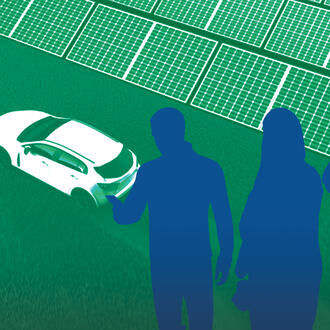Credit: mars58 / iStock
Americans have debated the risks of getting on a plane during the COVID-19 pandemic — especially during the summer vacation season — with few clear answers or evidence to guide their decisions.
The airline industry itself has been split over pandemic safety approaches, with airlines including Delta, JetBlue, Alaska, and Southwest opting not to sell middle seats to provide more distance between passengers and reduce the risk of illness. Other airlines, like United, Spirit, and American Airlines, are not blocking middle seats, with United’s chief communications officer calling the idea “a PR strategy” instead of a safety strategy.
“I've been doing research about aviation safety from a statistical viewpoint for many, many years, and this is the first time that I've seen where U.S. domestic airlines disagreed overtly on a matter related to safety,” MIT Sloan professor and aviation safety expert said. “It seemed to me that all we were getting was a clash of conjectures.”
A new working paper by Barnett, “COVID-19 Risk Among Airline Passengers: Should the Middle Seat Stay Empty?” sheds some light on the issue, finding that empty middle seats do decrease a passenger’s risk of contracting coronavirus on a flight by a factor of about 1.8. The overall risk from flying, Barnett also found, is similar to the risk of doing other day-to-day activities during the pandemic, like going to the supermarket or using public transportation. The paper has not been peer-reviewed.
With powerful air purification systems, airplanes are “not like a typical indoor environment, so it is safe for that respect. But even so, you're much closer to people for a longer period of time than you would be normally,” Barnett said. “In a supermarket, you can typically achieve social distancing … you can achieve physical separation in these places that you can't achieve on the plane.”
For the study, Barnett calculated the risk of two hours (the average time for domestic flights) of coach-class domestic air travel in the United States with all seats full or with all seats except for middle seats full.
In making his estimates, Barnett approximated the probability that a given airline passenger has COVID-19, the probability that universal masking could prevent a contagious passenger from spreading the disease, and how risk of infection changes based on the locations of the infected and non-infected passengers.
Barnett assumed that everyone on a plane is wearing masks (all U.S. airlines have mandated mask policies), and that the primary risk to passengers comes from others in the same row and, to a lesser degree, the rows behind or in front of the passenger. Seatbacks provide some measure of protection from passengers in other rows, Barnett said. Other passengers do not pose as much of a risk because of the air purification systems on airplanes, he said.
The calculations showed that when all seats are sold, the probability of getting COVID-19 from a nearby passenger is one in 4,300. If middle seats are empty, risk goes down to one in 7,700.
For a coach passenger who has a 1% chance of dying if infected with COVID-19, the estimated mortality risk on a full flight is one in 430,000, Barnett said, and one in 770,000 if middle seats are empty.
Airlines don’t always sell every seat on a plane, though. The risk of dying from the disease when 85% of seats are filled — the average amount of seats sold on flights in 2019 — is one in 540,000. For comparison, the chance of being killed in a plane crash is one in 34 million, Barnett said.Passengers infected by the virus can also spread it to others after the flight. Barnett found that if an infected passenger causes 0.5 other new infections (a conservative estimate), the resulting number of deaths from a full flight would be one per 310,000 passengers, and one per 390,000 if a flight is 85% full. If a flight has middle seats empty, the rate declines to one per 550,000 passengers.
When all seats are sold, the probability of getting COVID-19 from a nearby airplane passenger is one in 4,300.
Barnett said these estimates are subject to known and unknown sources of uncertainty, and have a “considerable” margin of error of a factor of 2.5. But the margin of error affects both filling all seats and leaving middle seats open the same way, he said, so the ratio between filling all seats and leaving middle seats empty would remain about the same at 1.8. The chances of being infected with or dying from COVID-19 from a flight are both higher than dying in an airplane crash. And flying with filled middle seats increases that health risk, Barnett said. But everything that involves being around other people or being in public is riskier during a pandemic. Flying during the pandemic is not necessarily riskier than two hours of everyday activity right now, Barnett said.
“Everything is more dangerous these days, you could say,” Barnett said. “Is it really more dangerous to fly than to engage in everyday activities? It’s not more dangerous, but it’s not less dangerous.”
The relative risk for passengers might depend on the level of infection where they live, and whether they are practicing social distancing or not.
Meanwhile, the airline industry, like many other sectors, is struggling during the pandemic upheaval and likely faces a fall downturn. A $25 billion government bailout is paying airline employee salaries until the end of September, and some lawmakers have said they want to include more money for the sector in the next coronavirus aid package. Barnett said a fuller recovery depends on positive developments in fighting COVID-19, like a vaccine
“Business travel continues to be very, very low,” Barnett said — for example, people are turning to online teleconferencing platforms for meetings or conferences that would otherwise happen in person. “The only people flying, by and large, are people who were engaged in leisure travel … but that will end very soon. I think the airlines expect that demand will diminish beginning next month, September, which is normally a relatively slow month.”
Read "COVID-19 Risk Among Airline Passengers: Should the Middle Seat Stay Empty?"



